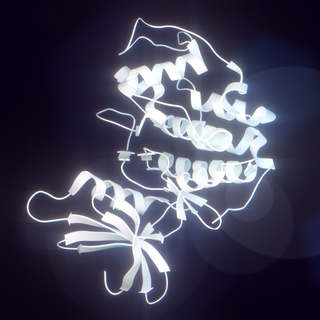
p53, also known as Tumor protein P53, cellular tumor antigen p53, or transformation-related protein 53 (TRP53) is a regulatory protein that is often mutated in human cancers. The p53 proteins are crucial in vertebrates, where they prevent cancer formation. As such, p53 has been described as "the guardian of the genome" because of its role in conserving stability by preventing genome mutation. Hence TP53 is classified as a tumor suppressor gene.

Aurora kinase A also known as serine/threonine-protein kinase 6 is an enzyme that in humans is encoded by the AURKA gene.

Cyclin-dependent kinase 1 also known as CDK1 or cell division cycle protein 2 homolog is a highly conserved protein that functions as a serine/threonine protein kinase, and is a key player in cell cycle regulation. It has been highly studied in the budding yeast S. cerevisiae, and the fission yeast S. pombe, where it is encoded by genes cdc28 and cdc2, respectively. With its cyclin partners, Cdk1 forms complexes that phosphorylate a variety of target substrates ; phosphorylation of these proteins leads to cell cycle progression.

Glycogen synthase kinase-3 beta, (GSK-3 beta), is an enzyme that in humans is encoded by the GSK3B gene. In mice, the enzyme is encoded by the Gsk3b gene. Abnormal regulation and expression of GSK-3 beta is associated with an increased susceptibility towards bipolar disorder.

DNA replication licensing factor MCM2 is a protein that in humans is encoded by the MCM2 gene.

CDK-activating kinase assembly factor MAT1 is an enzyme that in humans is encoded by the MNAT1 gene.

Homeodomain-interacting protein kinase 2 is an enzyme that in humans is encoded by the HIPK2 gene. HIPK2 can be categorized as a Serine/Threonine Protein kinase, specifically one that interacts with homeodomain transcription factors. It belongs to a family of protein kinases known as the DYRK kinases. Within this family HIPK2 belongs to a group of homeodomain-interacting protein kinases (HIPKs), including HIPK1 and HIPK3. HIPK2 can be found in a wide variety of species and its functions in gene expression and apoptosis are regulated by several different mechanisms.

Cyclin-H is a protein that in humans is encoded by the CCNH gene.

Dual specificity mitogen-activated protein kinase kinase 5 is an enzyme that in humans is encoded by the MAP2K5 gene.

Cell division cycle 7-related protein kinase is an enzyme that in humans is encoded by the CDC7 gene. The Cdc7 kinase is involved in regulation of the cell cycle at the point of chromosomal DNA replication. The gene CDC7 appears to be conserved throughout eukaryotic evolution; this means that most eukaryotic cells have the Cdc7 kinase protein.

Serine/threonine-protein kinase MARK1 is an enzyme that in humans is encoded by the MARK1 gene.

Protein phosphatase 1A is an enzyme that in humans is encoded by the PPM1A gene.

Lymphokine-activated killer T-cell-originated protein kinase is an enzyme that in humans is encoded by the PBK gene.

60S ribosomal protein L11 is a protein that in humans is encoded by the RPL11 gene.

ETS domain-containing protein Elk-4 is a protein that in humans is encoded by the ELK4 gene.

Serine/threonine-protein kinase PLK2 is an enzyme that in humans is encoded by the PLK2 gene.

Large tumor suppressor kinase 2 (LATS2) is an enzyme that in humans is encoded by the LATS2 gene.

Ras-related protein Rab-35 is a protein that in humans is encoded by the RAB35 gene. This GTPase participates in the traffic of recycling endosomes toward the plasma membrane,

The G2-M DNA damage checkpoint is an important cell cycle checkpoint in eukaryotic organisms that ensures that cells don't initiate mitosis until damaged or incompletely replicated DNA is sufficiently repaired. Cells with a defective G2-M checkpoint will undergo apoptosis or death after cell division if they enter the M phase before repairing their DNA. The defining biochemical feature of this checkpoint is the activation of M-phase cyclin-CDK complexes, which phosphorylate proteins that promote spindle assembly and bring the cell to metaphase.

In molecular biology, the kinase binding protein CGI-121 family of proteins includes the kinase binding protein CGI-121 and its homologues. CGI-121 has been shown to bind to the p53-related protein kinase (PRPK). CGI-121 is part of a conserved protein complex, KEOPS. The KEOPS complex is involved in telomere uncapping and telomere elongation. This family of proteins also include archaeal homologues.






















